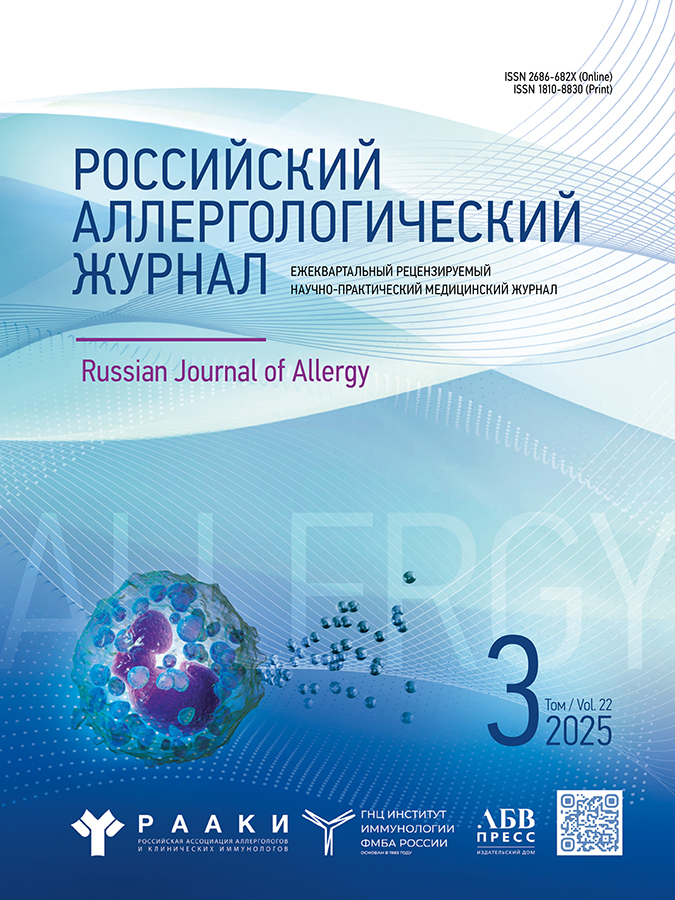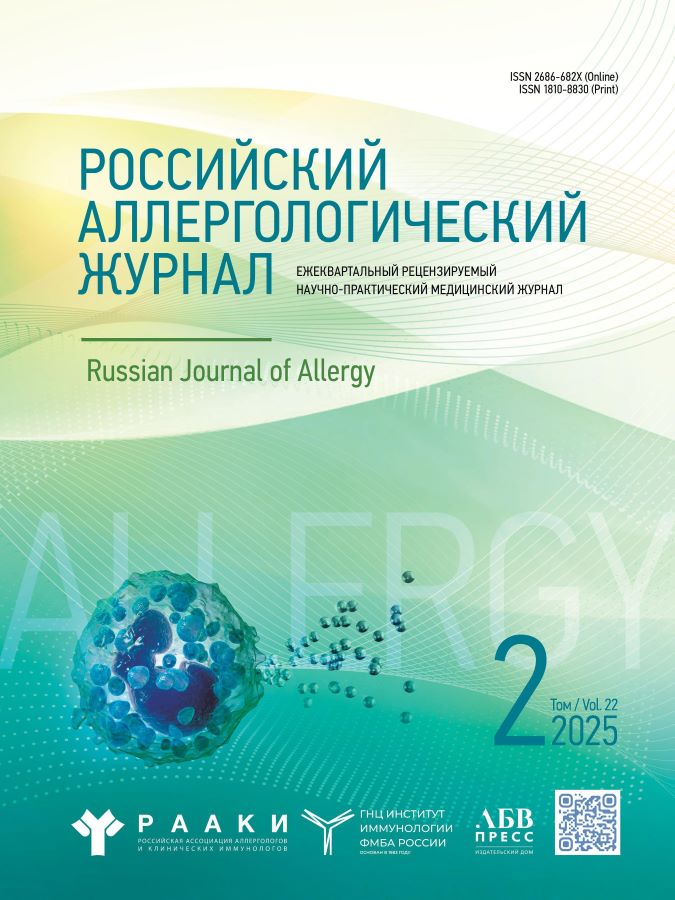Approach to choosing antihistamines for treatment of itchy dermatoses
- Authors: Nenasheva N.M.1, Nasunova A.Y.1
-
Affiliations:
- Russian Medical Academy of Continuing Professional Education
- Issue: Vol 22, No 2 (2025)
- Pages: 165-178
- Section: Reviews
- Submitted: 29.04.2025
- Accepted: 14.05.2025
- Published: 03.06.2025
- URL: https://rusalljournal.ru/raj/article/view/17024
- DOI: https://doi.org/10.36691/RJA17024
- ID: 17024
Cite item
Abstract
Every third patient who makes an appointment with a specialist (dermatologist or allergologist-immunologist) suffers from itchy dermatosis. Traditionally, in Russia this term includes such diseases as atopic dermatitis, contact dermatitis, eczema and urticaria. Pathogenesis of these diseases is based on immune-mediated skin inflammation characterized by itching of varying degrees of intensity. Itching can affect productivity, sleep quality and mood, aggravate skin diseases and lead to complications. Modern antihistamines are used to control itching as monotherapy or as an addition to topical treatment. Among non-sedating antihistamines, levocetirizine holds a special place with its favorable pharmacological profile. Rapid action and optimal duration of action in combination with low risk of drug interactions, good tolerability, absence of influence on cognitive and psychomotor functions and cardiac safety make levocetirizine the drug of first choice in treatment of skin itching in itchy dermatoses. Real practice confirms the claimed characteristics of the medicine.
Full Text
About the authors
Natalya M. Nenasheva
Russian Medical Academy of Continuing Professional Education
Email: 1444031@gmail.com
ORCID iD: 0000-0002-3162-2510
SPIN-code: 3363-6170
MD, Dr. Sci. (Medicine), Professor
Россия, MoscowAysa Yu. Nasunova
Russian Medical Academy of Continuing Professional Education
Author for correspondence.
Email: aysanasunova@gmail.com
ORCID iD: 0009-0006-7116-9091
SPIN-code: 9297-8223
д-р мед. наук, профессор
Россия, MoscowReferences
- De Monchy JG, Demoly P, Akdis CA, et al. Allergology in Europe, the blueprint. Allergy. 2013;68(10):1211–1218. doi: 10.1111/all.12225 EDN: SPFQTB
- Van de Veen W, Akdis M. Mechanisms of immune regulation in allergy. In: Akdis CA, Agache I. EAACI global atlas of allergy. Zurich: European Academy of Allergy and Clinical Immunology, 2014. Pp. 90–91.
- Genuneit J, Seibold AM, Apfelbacher CJ, et al. Overview of systematic reviews in allergy epidemiology. Allergy. 2017;72(6):849–856. doi: 10.1111/all.13123
- Kubanov AA, Bogdanova EV. Dermatovenereology in the Russian Federation: results of 2023. Vestnik Dermatologii i Venerologii. 2024;100(4):9–24. (In Russ.) doi: 10.25208/vdv16795 EDN: PVEPLO
- Lee HH, Patel KR, Singam V, et al. A systematic review and meta-analysis of the prevalence and phenotype of adult-onset atopic dermatitis. J Am Acad Dermatol. 2019;80(6):1526–1532.e7. doi: 10.1016/j.jaad.2018.05.1241
- Kubanov АА, Bogdanova EV. Resources and performance rates of medical organizations providing medical care in the field of dermatovenereology in the Russian Federation in 2016–2022. Vestnik Dermatologii i Venerologii. 2023;99(4):18–40. (In Russ.) doi: https://doi.org/10.25208/vdv12385 EDN: TQVQUL
- Langan SM, Irvine AD, Weidinger S. Atopic dermatitis. Lancet. 2020;396(10247):345–360. doi: 10.1016/S0140-6736(20)31286-1
- Атопический дерматит. Клинические рекомендации. Российская ассоциация аллергологов и клинических иммунологов; Союз педиатров России; Российское общество дерматовенерологов и косметологов; Национальный альянс дерматовенерологов и косметологов. 2024. Режим доступа: https://cr.minzdrav.gov.ru/preview-cr/265_3 Дата обращения: 20.03.2025.
- Barbarot S, Auziere S, Gadkari A, et al. Epidemiology of atopic dermatitis in adults: results from an international survey. Allergy. 2018;73(6):1284–1293. doi: 10.1111/all.13401 EDN: YFOLPV
- Schleimer RP, Berdnikovs S. Etiology of epithelial barrier dysfunction in patients with type 2 inflammatory diseases. J Allergy Clin Immunol. 2017;139(6):1752–1761. doi: 10.1016/j.jaci.2017.04.010
- Rozas-Muñoz E, Gamé D, Serra-Baldrich E. Allergic contact dermatitis by anatomical regions: diagnostic clues. Actas Dermosifiliogr (Engl Ed). 2018;109(6):485–507. (In English, Spanish) doi: 10.1016/j.ad.2017.05.011
- Bains SN, Nash P, Fonacier L. Irritant contact dermatitis. Clin Rev Allergy Immunol. 2019;56(1):99–109. doi: 10.1007/s12016-018-8713-0 EDN: VHLMUW
- Pesqué D, Aerts O, Bizjak M, et al. Differential diagnosis of contact dermatitis: a practical-approach review by the EADV Task Force on contact dermatitis. J Eur Acad Dermatol Venereol. 2024;38(9):1704–1722. doi: 10.1111/jdv.20052 EDN: YSZSMA
- Дерматит контактный. Клинические рекомендации. Российская ассоциация аллергологов и клинических иммунологов; Союз педиатров России; Российское общество дерматовенерологов и косметологов; Национальный альянс дерматовенерологов и косметологов. 2024. Режим доступа: https://cr.minzdrav.gov.ru/preview-cr/213_3 Дата обращения: 20.03.2025.
- Johnston GA, Exton LS, Mohd Mustapa MF, et al. British association of dermatologists’ guidelines for the management of contact dermatitis 2017. Br J Dermatol. 2017;176(2):317–329. doi: 10.1111/bjd.15239
- Экзема. Клинические рекомендации. Российское общество дерматовенерологов и косметологов. 2024. Режим доступа: https://cr.minzdrav.gov.ru/preview-cr/246_3 Дата обращения: 20.03.2025.
- Amar SM, Dreskin SC. Urticaria. Prim Care. 2008;35(1):141–157, doi: 10.1016/j.pop.2007.09.009
- Poonawalla T, Kelly B. Urticaria: a review. Am J Clin Dermatol. 2009;10(1):9–21. doi: 10.2165/0128071-200910010-00002 EDN: VKOMGE
- Крапивница. Клинические рекомендации. Российская ассоциация аллергологов и клинических иммунологов; Союз педиатров России; Российское общество дерматовенерологов и косметологов. 2024. Режим доступа: https://cr.minzdrav.gov.ru/view-cr/264_2 Дата обращения: 20.03.2025.
- Ben-Shoshan M, Kanani A, Kalicinsky C, Watson W. Urticaria. Allergy Asthma Clin Immunol. 2024;20(Suppl 3):64. doi: 10.1186/s13223-024-00931-6 EDN: MCLLYV
- Fricke J, Ávila G, Keller T, et al. Prevalence of chronic urticaria in children and adults across the globe: systematic review with meta-analysis. Allergy. 2020;75(2):423–432. doi: 10.1111/all.14037 EDN: TVBISP
- Антигистаминные препараты в клинической практике: клиническое руководство для врачей. Под ред. Н.М. Ненашевой. Москва: Медконгресс, 2024. 96 с.
- Church MK, Church DS. Pharmacology of antihistamines. Indian J Dermatol. 2013;58(3):219–224. doi: 10.4103/0019-5154.110832
- Kovalenko IA, Kruglova LS, Shatokhina EA. Current views on the mechanisms of development and pharmacotherapy of pruritus. Russian Journal of Clinical Dermatology and Venereology. 2021;20(1):90–96. (In Russ.) doi: 10.17116/klinderma20212001190 EDN: ZGPSFV
- Kim JH, Ha EK, Han B, et al. First-generation antihistamines and seizures in young children. JAMA Netw Open. 2024;7(8):e2429654. doi: 10.1001/jamanetworkopen.2024.29654 EDN: JGAYXJ
- Molimard M, Diquet B, Benedetti MS. Comparison of pharmacokinetics and metabolism of desloratadine, fexofenadine, levocetirizine and mizolastine in humans. Fundam Clin Pharmacol. 2004;18(4):399–411. doi: 10.1111/j.1472-8206.2004.00254.x
- Карева Е.Н. Выбор антигистаминного препарата: взгляд фармаколога. РМЖ. 2016;12:811–816.
- Rico S, Antonijoan R, Barbanoj M. Ebastine in the light of CONGA recommendations for the development of third-generation antihistamines. J Asthma Allergy. 2009;2:73–92. doi: 10.2147/jaa.s3108
- Bosma R, van den Bor J, Vischer HF, et al. The long duration of action of the second generation antihistamine bilastine coincides with its long residence time at the histamine H1 receptor. Eur J Pharmacol. 2018;838:107–111. doi: 10.1016/j.ejphar.2018.09.011
- Grant JA, Riethuisen JM, Moulaert B, DeVos C. A double-blind, randomized, single-dose, crossover comparison of levocetirizine with ebastine, fexofenadine, loratadine, mizolastine, and placebo: suppression of histamine-induced wheal-and-flare response during 24 hours in healthy male subjects. Ann Allergy Asthma Immunol. 2002;88(2):190–197. doi: 10.1016/s1081-1206(10)61995-3
- Hair PI, Scott LJ. Levocetirizine: a review of its use in the management of allergic rhinitis and skin allergies. Drugs. 2006;66(7):973–996. doi: 10.2165/00003495-200666070-00017 EDN: WIBPFQ
- Devillier P, Roche N, Faisy C. Clinical pharmacokinetics and pharmacodynamics of desloratadine, fexofenadine and levocetirizine: a comparative review. Clinical Pharmacokinetics. 2008;47(4):217–230. doi: 10.2165/00003088-200847040-00001 EDN: MVVPNV
- Dukhanin AS. Pharmacological profile of antihistamines: focus on unwanted drug interactions. Russian Journal of Allergy. 2020;17(4):46–56. doi: 10.36691/RJA1407 EDN: SUYBAJ
- Tashiro M, Kato M, Miyake M, et al. Dose dependency of brain histamine H(1) receptor occupancy following oral administration of cetirizine hydrochloride measured using PET with [11C] doxepin. Hum Psychopharmacol. 2009;24(7):540–548. doi: 10.1002/hup.1051
- Аллервэй. Регистрационное удостоверение ЛП-№(001333)-(РГ-RU). Государственный реестр лекарстенных средств. Режим доступа: https://grls.rosminzdrav.ru/Grls_View_v2.aspx?routingGuid=8ba99691-03c4-4dba-a254-93d932830ef4 Дата обращения: 20.03.2025.
- Аллервэй Экспресс. Регистрационное удостоверение ЛП-006153. Государственный реестр лекарстенных средств. Режим доступа: https://grls.rosminzdrav.ru/Grls_View_v2.aspx?routingGuid=d8b3682d-9729-40b7-a890-cedeb90e9286 Дата обращения: 20.03.2025.
- Kruglova LS, Lvov AN, Araviyskaya ER, et al. The use of Cetirizine and Levocetirizine in patients with chronic urticaria and other allergic dermatoses: issues of dosage increasing and long-term use. Resolution of the Advisory Board. Russian Journal of Allergy. 2022;19(3):388–403. (In Russ.) doi: 10.36691/RJA1574 EDN: CTGYQQ
- Nordeng H, Wegler C, Lindqvist A, et al. Transfer of cetirizine/levocetirizine into human breast milk and estimation of drug exposure to infants through breastfeeding: a human lactation study from the ConcePTION project. Basic Clin Pharmacol Toxicol. 2024;134(1):153–164. doi: 10.1111/bcpt.13948 EDN: BTNBZG
- Gushchin IS. A basis of multiple antiallergic effects of inverse H1-receptor agonists. PULMONOLOGIYA. 2008;(6):84–89. (In Russ.) doi: 10.18093/0869-0189-2008-0-6-84-89 EDN: JXGOBV
- Godse KV. Updosing of antihistamines to improve control of chronic urticaria. Indian J Dermatol Venereol Leprol. 2010;76(1):61–62. doi: 10.4103/0378-6323.58684
- Sharma VK, Gupta V, Pathak M, Ramam M. An open-label prospective clinical study to assess the efficacy of increasing levocetirizine dose up to four times in chronic spontaneous urticaria not controlled with standard dose. J Dermatolog Treat. 2017;28(6):539–543. doi: 10.1080/09546634.2016.1246705
- Staevska M, Popov TA, Kralimarkova T, et al. The effectiveness of levocetirizine and desloratadine in up to 4 times conventional doses in difficult-to-treat urticaria. J Allergy Clin Immunol. 2010;125(3):676–682. doi: 10.1016/j.jaci.2009.11.047
- Iriarte Sotés P, Armisén M, Usero-Bárcena T, et al. Efficacy and safety of up-dosing antihistamines in chronic spontaneous urticaria: a systematic review of the literature. J Investig Allergol Clin Immunol. 2021;31(4):282–291. doi: 10.18176/jiaci.0649 EDN: VPMSBX
- Guillén-Aguinaga S, Jáuregui Presa I, Aguinaga-Ontoso E, et al. Updosing nonsedating antihistamines in patients with chronic spontaneous urticaria: a systematic review and meta-analysis. Br J Dermatol. 2016;175(6):1153–1165. doi: 10.1111/bjd.14768
- Cataldi M, Maurer M, Taglialatela M, Church MK. Cardiac safety of second-generation H1-antihistamines when updosed in chronic spontaneous urticaria. Clin Exp Allergy. 2019;49(12):1615–1623. doi: 10.1111/cea.13500 EDN: AVTVYP
- Kruglova LS, Tataurschikova NS, Tipaeva EV. Issues of long-term use of antihistamines. Pharmateca. 2021;28(14):87–93. (In Russ.) doi: 10.18565/pharmateca.2021.14.87-93 EDN: YSHHPW
- Simons FE. Early Prevention of Asthma in Atopic Children (EPAAC) Study Group. Safety of levocetirizine treatment in young atopic children: an 18-month study. Pediatr Allergy Immunol. 2007;18(6):535–542. doi: 10.1111/j.1399-3038.2007.00558.x
- Kruglova LS, Masiukova SA, Abesadze GA. Modern antihistamines in comprehensive treatment of itching dermatoses. Russian Journal of Clinical Dermatology and Venereology. 2014;12(1):52–58. (In Russ.) EDN: RZQMFT
- Scordamaglia F, Compalati E, Baiardini I, et al. Levocetirizine in the treatment of allergic diseases. Expert Opin Pharmacother. 2009;10(14):2367–2377. doi: 10.1517/14656560903193086
- Snidvongs K, Seresirikachorn K, Khattiyawittayakun L, Chitsuthipakorn W. Sedative effects of levocetirizine: a systematic review and meta-analysis of randomized controlled studies. Drugs. 2017;77(2):175–186. doi: 10.1007/s40265-016-0682-0 EDN: YWJKGD
- Podder I, Dhabal A, Chakraborty SS. Efficacy and safety of up-dosed second-generation antihistamines in uncontrolled chronic spontaneous urticaria: a review. J Clin Aesthet Dermatol. 2023;16(3):44–50.
- Wettermark B, Trečiokienė I, Sporrong S, Druedahl L. Research methods in drug utilization research. In: Elseviers M, Wettermark B, Benkó R., et al. Drug utilization research. 2024. doi: 10.1002/9781119911685.ch2
- Engeland A, Bjørge T, Klungsøyr K, et al. Trends in prescription drug use during pregnancy and postpartum in Norway, 2005 to 2015. Pharmacoepidemiol Drug Saf. 2018;27(9):995–1004. doi: 10.1002/pds.4577 EDN: YKMASL
- Stephansson O, Granath F, Svensson T, et al. Drug use during pregnancy in Sweden — assessed by the Prescribed Drug Register and the Medical Birth Register. Clin Epidemiol. 2011;3:43–50. doi: 10.2147/CLEP.S16305
Supplementary files








